Xiahe to Lanzhou to Jiayuguan
There aren't any direct buses from Langmusi to Lanzhou, so you have to transfer in Hezuo. Some reports suggest that there are two different stations in Hezuo and that you might have to take a taxi between them, but I was able to transfer at the same station.
Arriving in Lanzhou, I thought I would probably have to transfer stations in order to get a train to Jiayuguan, but one of the drivers in the bus-station courtyard, before I could even make it into the station, said they could take me there. They weren't leaving for a few hours, and it was a night bus, so I left my bag with them and went out to explore the city for a few hours.
Lanzhou didn't make a huge impression on me. I saw an interesting mosque, but like most Chinese cities it seemed to be a temple to capitalism, with modern shopping malls quickly replacing anything that might have looked traditional. And although Lanzhou supposedly has the most polluted air in China, the air there was a lot clearer on both the times I was there than it was when I was in Beijing.
Although I returned about a half hour before the bus was scheduled to leave, apparently I was later than they wanted; when they saw me coming the rushed me onto the bus and we quickly left. This was my first sleeper bus. These buses have three rows of bunks, but you can't lie flat on them, as they have an inclined back and head area, with your feet going into a compartment below the head of the person in front of you. Although they're actually pretty good for sleeping, by the same token they're definitely not designed for people more than 6 feet/180 cm tall.
 |
| Typical sleeper bus configuration. |
We arrived in Jiayuguan before dawn, which is to say
sometime before 6:30 am, and since the bus didn't terminate in Jiayuguan
we were dumped on the edge of town where the highway passed by. A taxi
delivered us to the center early in the morning, and I wandered around
looking for a place to stay. Like Lanzhou, however, nowhere would accept
foreigners except for those that charged more than 160 yuan per night.
That's too rich for my blood, so I decided to stay the day and take a
train that night to Dunhuang. It's both frustrating and unsurprising that China appears not to want many foreigners to see the west of the country, with their crackdowns especially affecting budget tourists who are more likely to interact with locals and less likely to be taking tours.
In order to figure out what I was going to do I again had to rely on a friendly internet cafe to help me get online, and suss out train schedules and how to get to the station by bus. I made my way to the train station, bought the only kind of ticket they had left—standing room on a 3:00 am train—dropped my bag at the left-luggage room, and headed back into town to see if I could rent a bike at the Jiayuguan Binguan. After locating the hotel (there are multiple buildings in the same compound, so finding the right person to talk to was slightly difficult) and finding the right person, I was able to rent a bike. This was great, as biking to the sights was really a great way to see the sights and enjoy the landscape. It's too bad that more places don't rent bicycles in China, as it's a great way to explore and I used to rent bikes in SE Asia all the time. Step up your game, China! Oh wait, I forgot that they don't care about foreigners and no self-respecting, loaded Chinese tourist would ride a bicycle anywhere.
Fort Jiayuguan
Fort Jiayuguan basically marked the farthest western extent of Ming China, strategically located at the narrowest point of the Hexi Corridor, and it's where the Great Wall ended. There are some pretty amazing pictures out there of the fort with snowy mountains in the background, and it's a pretty impressive sight at any time of the year.
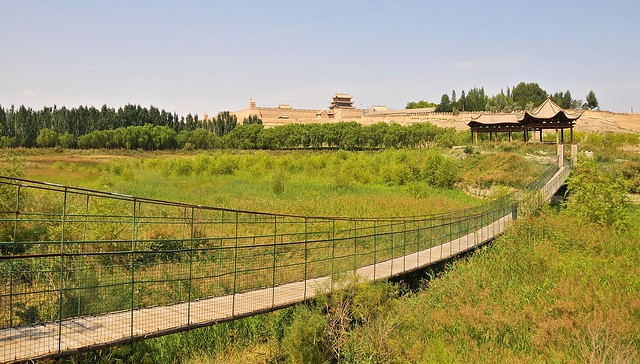 |
| There's a park and pond just southeast of the fort. It's surprisingly unkempt for a Chinese park. |
 |
| As in Dunhuang, tourists can get rides in ultralight gliders to fly over the fort. |
 |
| Poppies at the base of the wall, from the south. |
Jiayuguan Fort is surrounded by an outer wall and an inner wall. The outer wall, which you can see above, is fairly small, but encloses a much larger space than the inner wall. The inner wall is much more massive and encloses a much smaller area.
 |
| The inner wall and fort is the small box on the left. The outer wall
encloses it, and then all of the green area is the modern park
surrounding it, which includes a museum. |
 |
| Tourists can play dress-up inside the inner wall. |
 |
| Looking north over the fort and inner wall, which is much more substantial. The restored stretches of the Great Wall are in the mountains back there. |
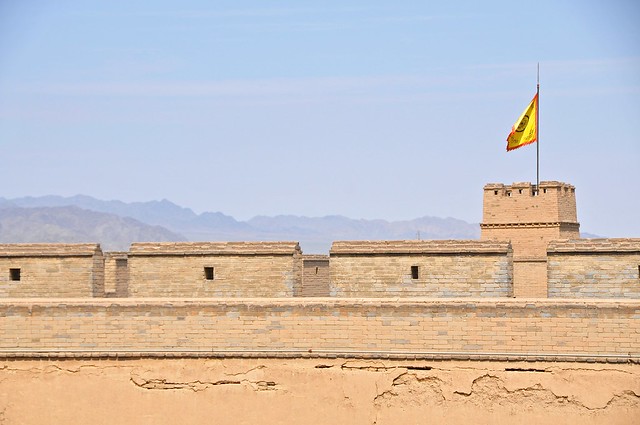 |
| Almost everything at the fort is a reconstruction. |
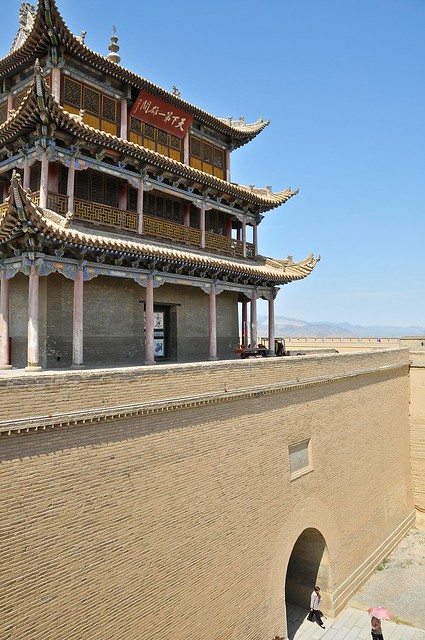 |
| There are three large, three-tiered Chinese-style buildings sitting on top of the inner walls: one on the east gate, one on the west gate, and one just inside the west gate. This is the east gate, or the Gate of Enlightenment, which is also of recent construction despite its weathered appearance.. |
 |
| The interior of the fort is now planted with lots of trees, in stark contrast to the surrounding desert. |
 |
| Corner tower joining the inner and outer walls, and the northern mountains beyond. |
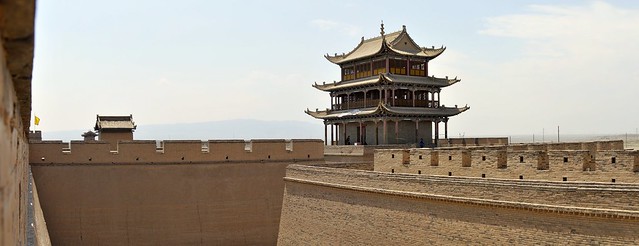 |
| Double layers of the inner walls, and the Gate of Sighs. |
 |
| Jiayuguan Fort was built to occupy a strategic location where the western end of the Hexi Corridor is at its narrowest, with mountains to the north and south. |
 |
| View from the inner courtyard. |
 |
| Looking at the western Gate of Sighs from underneath the adjacent Gate of Conciliation. Multiple gateways within the fort provided protection even if the outer perimeter was breached. |
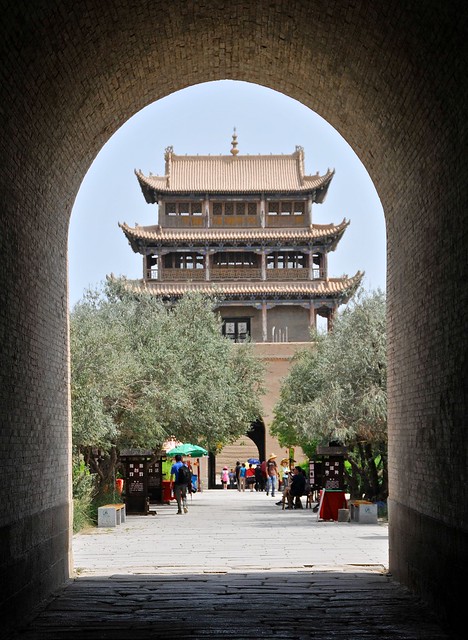 |
| The Gate of Enlightenment from under the gate of Reconciliation. This being China, of course there are lots of souvenir stores, vendors, and "historical" performances available for a fee. |
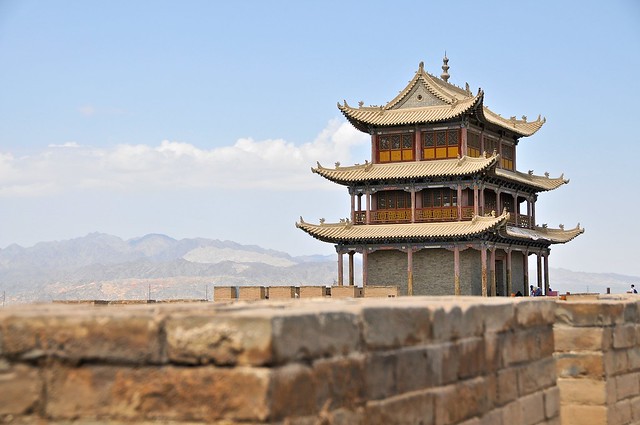 |
| Although a reconstruction, and although it's trying its best to be a Disneyfied attraction like so many in China, it's still a fairly untouristed and interesting place to visit. |
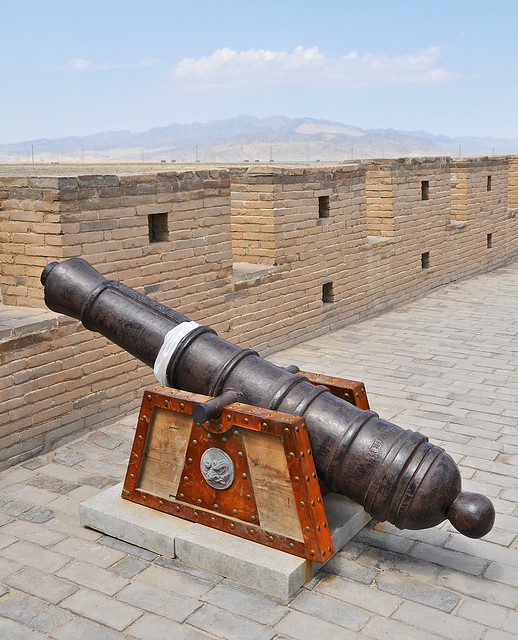 |
| An old canon protecting the ramparts. |
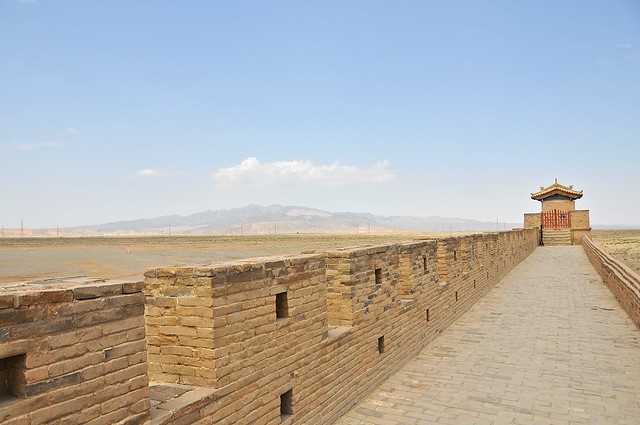 |
| You could probably see invaders coming from miles away. |
 |
| Camel rides available outside the west gate. |
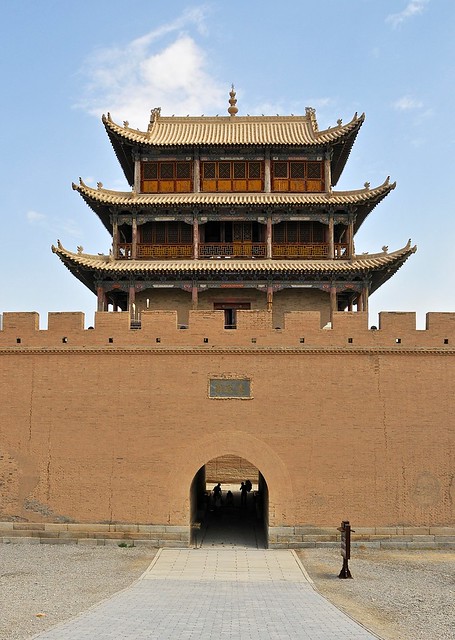 |
| The Gate of Sighs got its name from the sorrowful sighs travelers would emit as they left this, the last bastion of China, on the way to the wild western deserts. |
 |
| Looking up at the the Gate of Sighs. |
 |
| There's a compound for the fort's commander on the northern side of the grounds. |
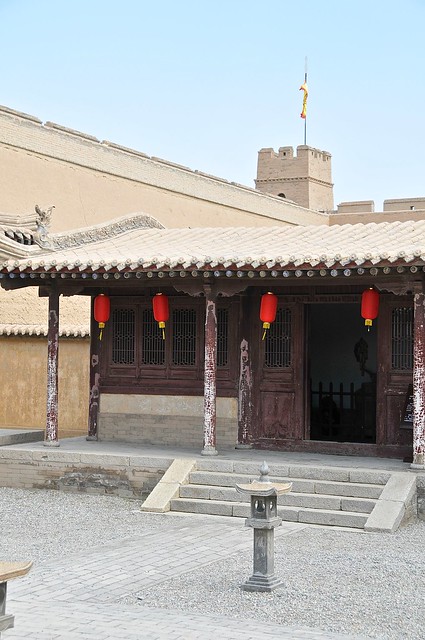 |
| The commander's quarters. |
The Overhanging Great Wall
There are two sections of the great Wall in the mountains just northwest of Fort Jiayuguan that have been restored, and they're known as the Overhanging Great Wall. One of the sections was restored by a private party, while the other is part of the official state attraction, along with Forth Jiayuguan and the First Beacon. Apparently the privately-owned section is better, as it was sympathetically restored and includes a small fort, while the official section shows typical Chinese over-restoration and theme-park levels of commercialization.
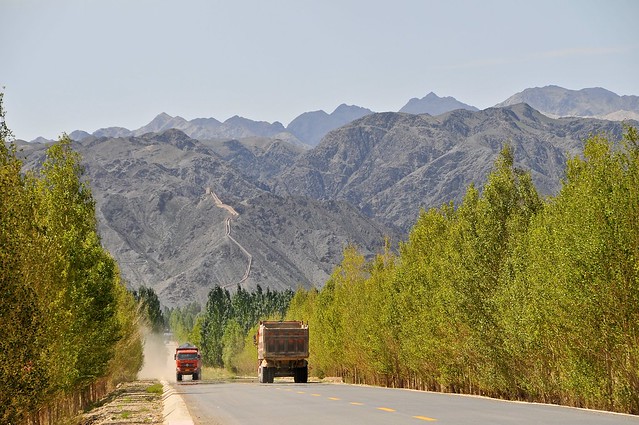 |
| We start getting a real Central-Asian flavour on the road to the Great
Wall reconstructions near the fort, passing through desert on roads
lined with poplars. The section of wall you see is the official section. |
 |
| A constant stream of trucks moves construction material about. The privately-owned section would be to the left of the most distant truck. |
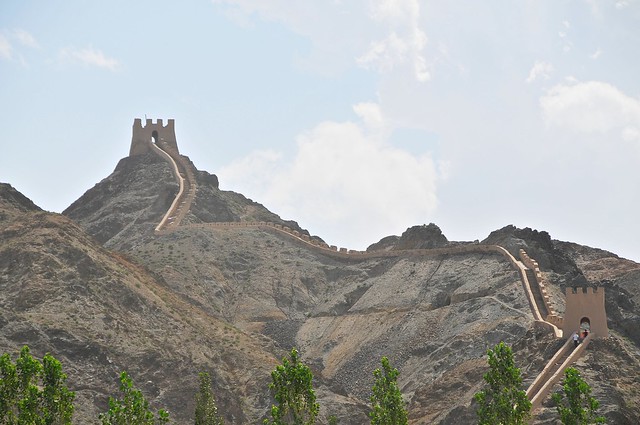 |
| This is the privately-owned section of wall. |
 |
| The ramparts of the fort at the privately-run site. |
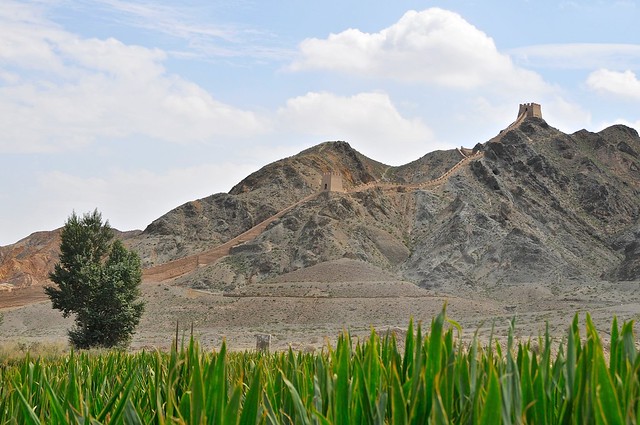 |
| The private section from fields separating the two sections of wall. |
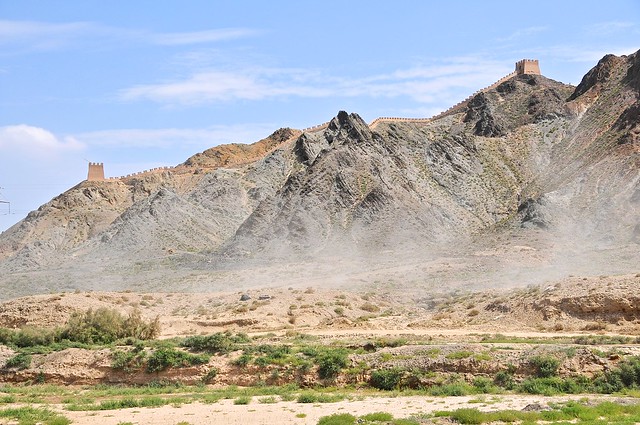 |
| The trucks churn up dust storms. |
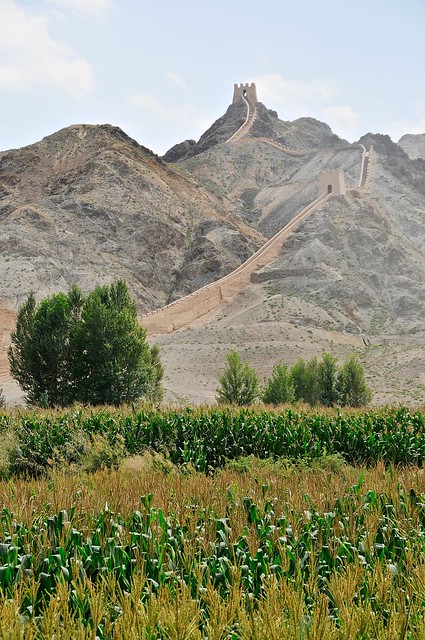 |
| Corn in the desert. |
 |
| This section of the Great Wal is about 300 meters further down the road, and is associated with the fort and the first beacon. You can buy a combination ticket for all three. |
 |
| At the base of the Overhanging Great Wall. |
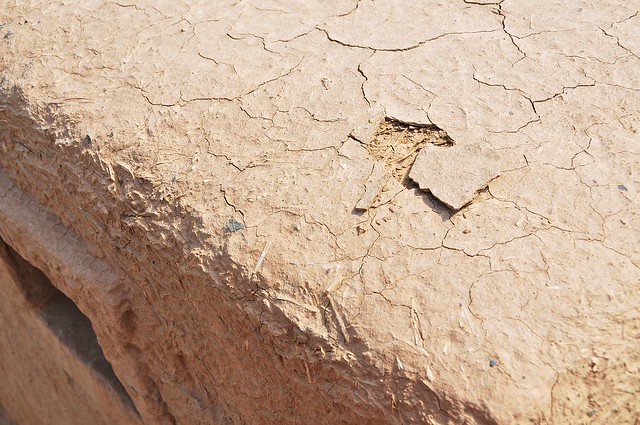 |
| The mud and straw used in the restoration doesn't look particularly durable. |
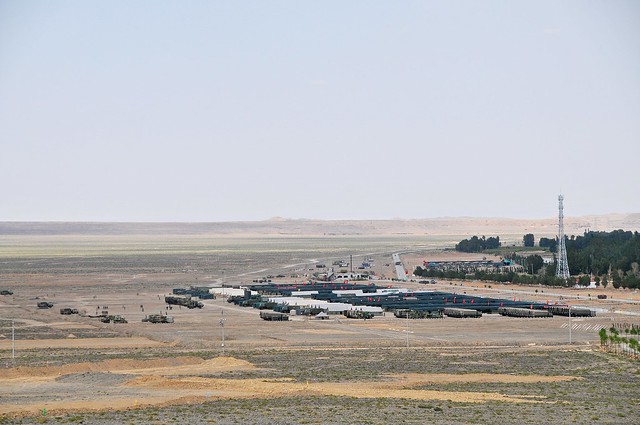 |
| There a Chinese military base just north of the Great Wall. |
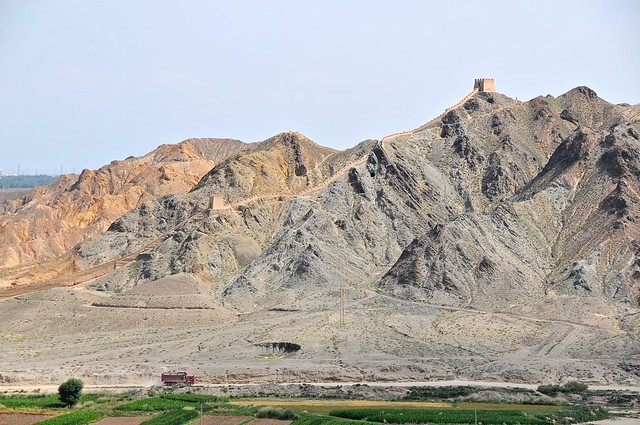 |
| The other section from partway up the official section. |
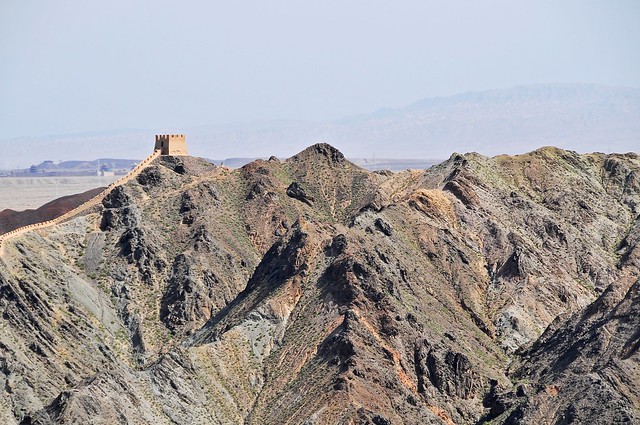 |
| Looking back towards the other section of the Great Wall, with the Fort visible just to the left of the watchtower. |
 |
| I wonder what the original wall actually looked like, as these walls don't seem like effective barricades to much of anything. |
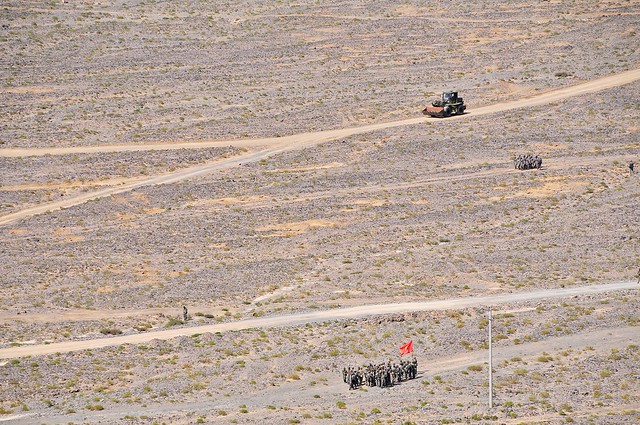 |
| Soldiers on exercises. I was kind of surprised to see them so close to a tourist site. |
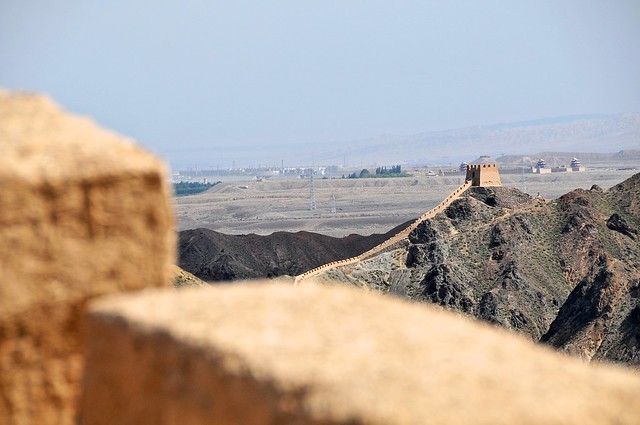 |
| Looking back over the ramparts towards the fort and town. |
 |
| Panorama of the end of the Overhanging Wall. |
 |
| There are a couple of mountain-top pagodas in the area. |
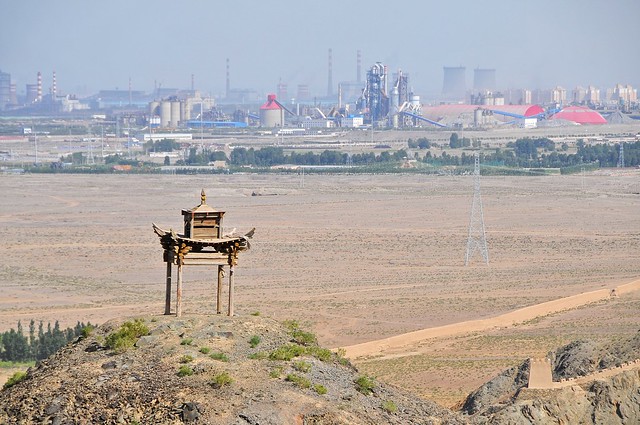 |
| Overlooking industrial Jiayuguan. |
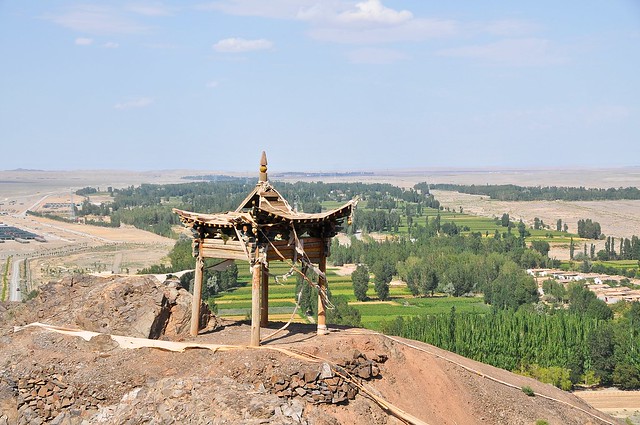 |
| A stretch of lush fields punctuate the desert, with the military base just visible on the left. |
 |
| A Chinese temple lies at the bottom of the mountain. |
 |
| I think the temple is more decorational than functional. |
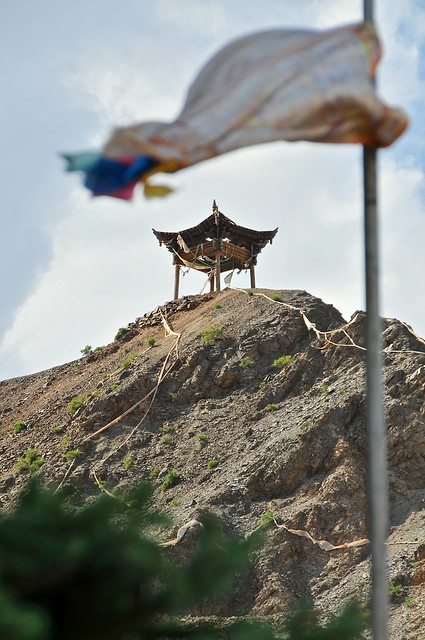 |
| Looking up at a pagoda from the temple. |
 |
| Tibetan-style prayer flags, but the colors are out of order: it should be blue, white, red, green, then yellow. |
 |
| A truck passes by every minute or so. Building never stops in China. |
 |
| The Fort from the road to the northwest. |
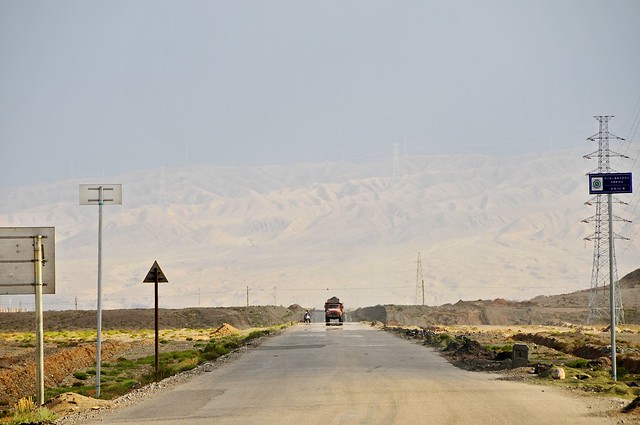 |
| Looking south towards the mountains on the other side of the Taolai river. |
The First Beacon
Unrestored stretches of wall run north from the fort up to the Overhanging Great Wall as well as south to the Taolai river. In its unrestored form, the wall looks like a big dirt mount, with perhaps some surviving brickwork on the upper levels. Where the wall meets the river the wall blossoms to an unrestored watchtower, which translates into a giant dirt mound. This watchtower functioned as the first beacon of the great wall, as fires would be lit in case of an invasion, and those fire signals would be propagated eastward.
I arrived at the entrance road and ticket office to the First Beacon at about 6:00, which was a bit late but the office should have been open since it doesn't close until sunset. Nevertheless, the gate was closed and there was no one there. A couple of Chinese on motorcycles showed up at about the same time, and then some people in minibuses. All of a sudden, the gatekeeper appeared and opened the gate for them after an exchange of money. I was also eventually let in after paying—and, to my surprise, received an official ticket—after which it was about a 10 minute cycle to the First Beacon. The real attraction is not the beacon, but the tourist complex built into the cliffs over the Taolai river, as they include a glass platform over the river and the opportunity to take a zip-line over the river for an additional charge. Very Chinese. There's also a historical exhibit spanning the river, with lots of tourist shops set in historical buildings.
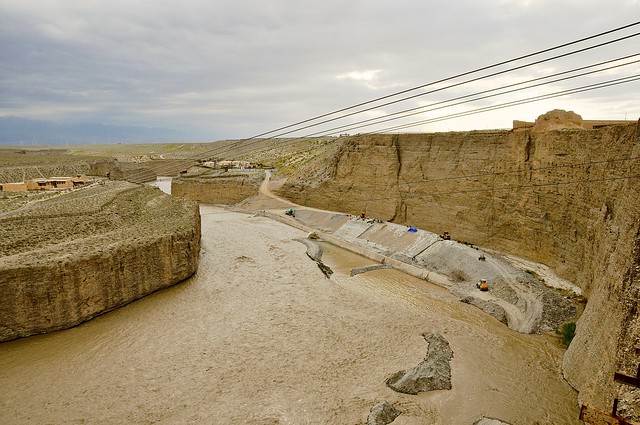 |
| What says cultural heritage better than a zip line over the river where the Great Wall terminates? I'm sure those bulldozers are busy making more tourist traps. |
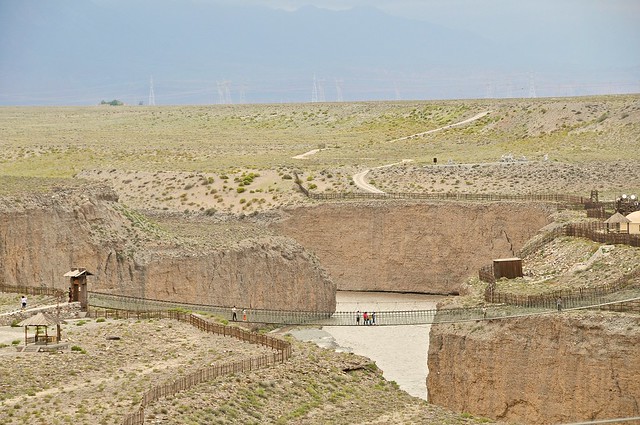 |
| Bridge between two little "historical" villages. |
 |
| The First Beacon in all its glory, with unrestored wall next to it. |
 |
| Atop an unrestored section, looking back at the end of the wall at cliff's edge. |
 |
| A section of the unrestored Great Wall, running from the fort down to the First Beacon. |
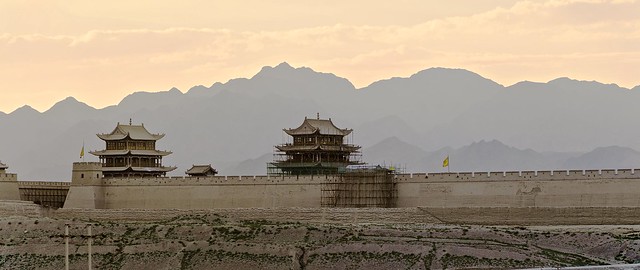 |
| The Gate of Sighs and Gate of Conciliation from south of the fort. |
 |
| All three gates at sunset. |
Budget
August 12 from Langmusi to Jiayuguan: 343 yuan
- Bus from Langmusi to Hezuo: 34 yuan
- Bus to Lanzhou: 74 yuan
- Bus to Jiayuguan: 208 yuan
- Snacks & shampoo: 4 yuan
- City bus x 2: 2 yuan
- Drinks, noodles, and snacks: 14 yuan
August 13 from Jiayuguan to Dunhuang: 215 yuan
- Bike rental: 30 yuan
- Entrance tickets: 60 + 11 + 11 yuan
- Luggage storage: 10 yuan
- Train ticket to Dunhuang: 54 yuan
- Shampoo to replace stuff I lost immediately after buying: 6 yuan
- City bus x 2: 2 yuan
- Internet & coke: 5 yuan
- 3 sodas, 2 ice teas, and snacks: 25 yuan
- Food bought on night bus: 11 yuan





























































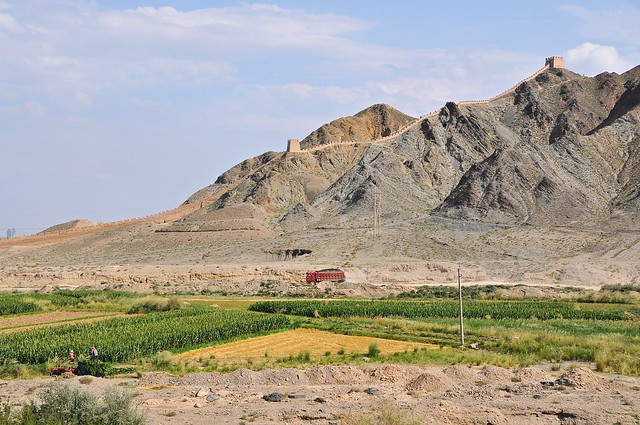
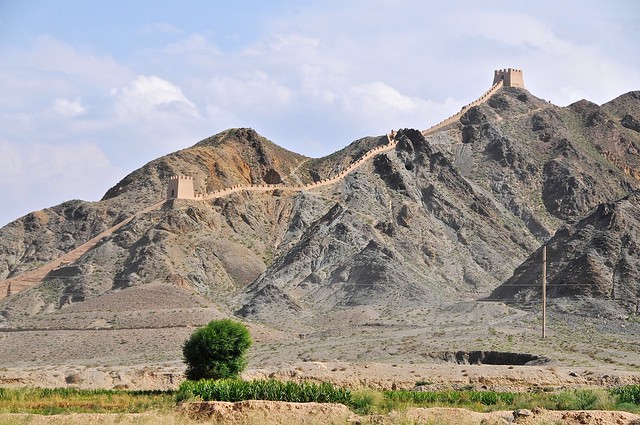
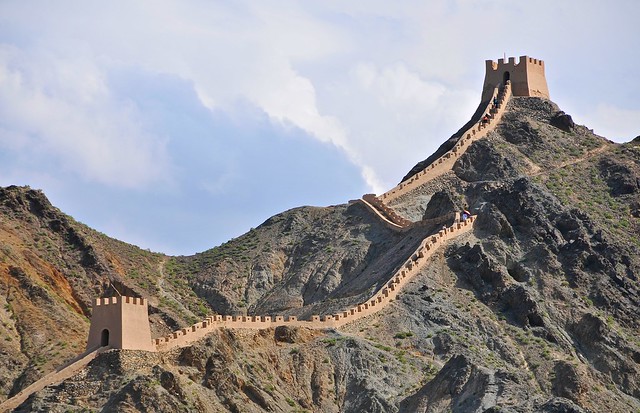
Great blog and pictures, thanks for sharing!
ReplyDeleteThanks. I know I include a lot more text and images than most people will find interesting, but I hope it was useful.
DeleteSince it's my intention to visit these Jiayuguan sites by bicycle, I would be interested by some time indications.
ReplyDeleteBeing present at Jiayuguan Fort at 08:00AM, do you think I could visit the Fort, the overhanging wall, the 1st Beacon, and return to Jiayuguan Bus Station for 03:00PM? All by bicycle.
After this, I would go by bus to the Silk Road Museum at Jiuquan.
Fabrice
DeleteAre you on your own bike? If so, it should be pretty easy to go from the Fort to the Wall to the Beacon and be back to the bus station by 3:00 pm. With a rental bike you'll be moving a little slower and have to return the bike and get to the station, but it should still be fairly easy so long as you watch the time. Even so, it actually shouldn't be that difficult, I think, if you are at the Fort at 8:00 am.
This comment has been removed by the author.
ReplyDeleteSnowcapped mountains would have been great and are an iconic view, but you probably have to be there in spring or early summer to see that.
ReplyDelete